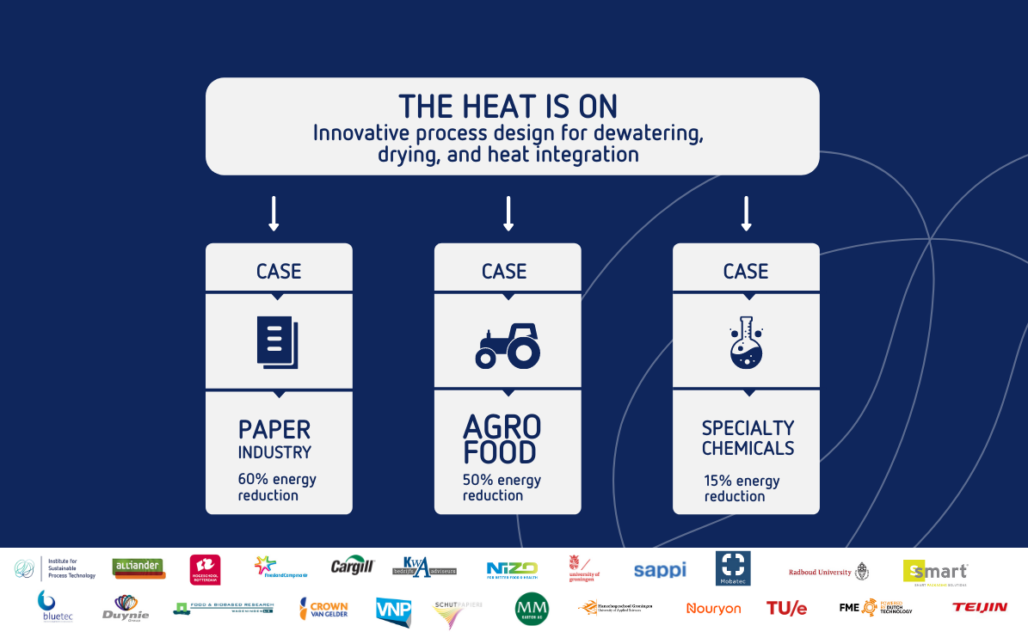The Heat is On aims to make processes for dewatering, drying and heat integration more efficient. Energy reductions in heat driven processes can be realised through integration of drying technology, ICT, heat pumps and other technologies.
In short:
- In many industries 40-80% of the CO2 emissions are related to heat driven processes like separation and drying
- Heat is now mainly generated from fossil fuels
- Heat integration aims to balance between heat generation and use/reuse
- The expected impact is up to 30% energy reduction in 2030
Heat driven processes are energy intensive
For industries like agrofood, paper and specialty chemicals, some 40-80% of the CO2 emissions is related to the energy that is needed for heat driven processes like separation and drying. Heat is now mainly generated from fossil fuels and cascades through processes from high to low temperature. Heat integration is a balancing act between generation and use/reuse. As a result, a small change to achieve more energy efficiency in one part of the process, can have substantial effects.
Towards efficient separation and drying processes
In THIO parallel efforts are being made to increase process efficiency in unit operations, through efficient separation and drying processes that decrease the amount of water to be evaporated and increase the heat upgrading potential and smart process optimisation and control through digital twins.
THIO applies a case driven system approach integrating these 3 innovations to achieve a significant savings in the amount of heat needed at the industry.
To obtain an optimal integral approach, the project innovations are organized from 2 perspectives:
- Increasing the technological readiness levels: Technology development teams develop required individual dewatering and drying technologies, methods and concepts needed.
- Increasing the innovation readiness levels: Case development teams focus on the realization of the impact at the industry partners, by integration of the technological solutions in the total heat reduction plan, ensuring appropriate business models and energy infrastructure, trained personnel, process control, etc.
This integrated system is supported and accelerated by a 3rd perspective:
- Increasing the operational readiness levels: an Exploitation and impact team aims to accelerate the uptake and implementation of insights from the project by professionals and students by an online learning environment and organization of Learning Communities.
Expected impact: 30% energy reduction
Expected impact: 30% energy reduction in 2030 on average in the 3 industry sectors (paper, agrofood and specialty chemicals): >3,0 Mton CO2 reduction in 2030 when implemented by all. THIO aims to have the following impact on the technical development:
- Efficient dewatering and drying using high solids technologies that result in 10% less water to be evaporated/dried and subsequent energy reduction
- Combined heat integration and drying innovations concepts that result in 50% less fossil fuel consumption for drying
- Smart manufacturing solutions that result in 10% energy savings due to improved process control
Through these technologies, we aim to make the following impact on 3 cases in the industry.

An amazing project team
This project covers a broad range of stakeholders with representatives from the industry and input from scientists and researchers. We are participating with companies with heat driven processes from the paper, agrofood and specialty chemicals industry, as well as knowledge, research and system integration partners to develop the technological solutions and convincing cases for the industry (e.g. finding, designing & testing innovations).
You might also be interested in
Acknowledgement & partners
This project is co-funded with subsidy from the Topsector Energy by the Ministry of Economic Affairs and Climate Policy.






























